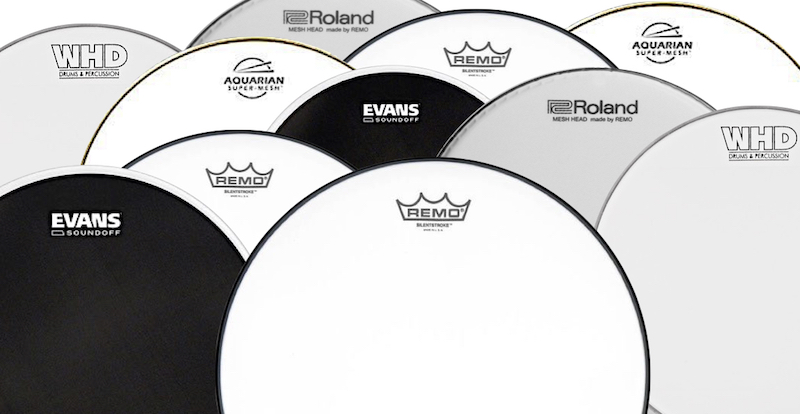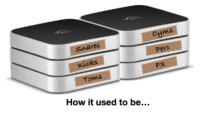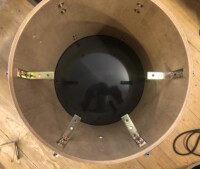Ok, ok, so we’ve looked at mesh before, but judging by some Facebook threads on the usual suspect’s pages, maybe we out to just cover a couple of things again.
-
Mesh does not feel like a real, mylar drum head. Due to its very nature (the fact that is it woven and not a single piece of polyester sheet), mesh heads stretch in a very, very different way to a ‘normal’ drum head. Mylar (the Dupont trade name for polyester and what Remo heads are made from) stretches evenly from centre to edge to give an even bounce. The nylon strands in a mesh head ‘roll’ over each other as pressure is applied and create a ‘tension pocket’ (my invention but I reckon it sounds pretty cool so I’m sticking with it) around the stick impact point. This focusses the tension back into the tip of the stick which makes it feel totally different to a Mylar head, and makes it feel much more springy. Hence, mesh heads (of all makes and designs) feel very different. Remember, the people who tell you that their mesh heads feel ‘just like’ ‘real’ heads are the ones who are trying to sell you them.
-
The thicker the mesh head, the better it feels. Absolutely… but…
-
The thicker the mesh head, the worse it triggers. Yes, thin, single ply mesh head are most sensitive, but generally feel pretty terrible (but can be improved – see later). Thicker heads feel ‘better’ (totally subjective), but trigger much worse at low velocities. This is why there is no one mesh head which suits all players – your dynamics (or lack or them) and your ‘touch’ should determine which mesh heads you use.
-
Mesh heads don’t trigger as well as Mylar heads. Yes, because a woven surface disperses it’s energy (your stick hit) much more efficiently than a Mylar head, any playing away from the pickup (whether it is in the centre or at the edge) on a mesh head will be detected at a much lower level than an equivalent mesh head, therefore giving an unrealistic trigger response. What do you mean the manufacturer of your electronic kit didn’t tell you that…??
-
A trigger on a mesh head will give a much lower output level than with identical settings on a Mylar head. Thats physics. You cant change it – Mylar is much more efficient (ie better) at transferring vibration around it’s surface.
-
To make a mesh head less bouncy, tighten it.Yes, I know that is counter intuitive, but try it. The tighter a mesh head, the higher the friction between the strands of the mesh head so the strands of the mesh ‘roll’ over each other less. This makes the head feel stiffer and, *GASP* more ‘realistic’.
-
Despite what the ‘media’ would have you believe, Remo Silentstroke heads are actually really good. Now you have been convinced that you really needed those custom lapped, triple ply, extra heavy wire mesh head to get an ‘accurate’ response, your drums trigger really badly. I’m sure you think single ply mesh heads (like the Silentstrokes) are rubbish too, don’t you? Go back and have a look at well build, single ply heads. Who better than the worlds biggest head manufacturers. Remo build (twin ply) mesh heads for Roland for years, so they know what they are doing, believe it or not. And no, I don’t have a deal with them.
-
The feel of any mesh head can be improved. If you are using mesh heads on real drums, just go and get some upholstery foam (the grey or yellow stuff) and cut a piece so that it rests around the inside of the shell, pressing agains the heads (cut it 2cm deeper than the shell to make it friction fit). This will dampen the head vibrations, make the mesh feel ‘deader’ and kill all stray vibrations which could cause uneven triggering. This is nothing new – ddrum (yes, them again) did this on the ddrum4 mesh pads back in the 1990’s and it worked brilliantly.
-
Mesh heads do not have to be expensive. A roll of industrial nylon mesh (enough to make a few hundred heads) will cost the same as a few mesh bass drum heads from some of the manufacturers. Admittedly they have the facility and the equipment to turn it into heads and you don’t, but don’t pay loads for a mesh head which has the same monetary value as a daily newspaper, has no sonic impact on your kit, and will not be seen by your adoring fans. There are some really good cheap mesh head manufacturers out there (check out ZED if you are in the UK and have access to eBay) and there are equivalents in Europe and the US. If you have just paid $100 for a mesh bass drum head, that better be some pretty incredible ‘acoustically inert’ ink in that logo stamp…
-
Logo can be removed from mesh heads. Yes, if you are sensitive about the look of your heads (or embarrassed by using cheaper mesh heads), get busy with a toothbrush (old, or from someone you really don’t like) and nail varnish remover (or gun-wash if you are feeling brave). Or, look for logo-less heads (Jobeky do them in the UK, as do others in other territories).
I’m sure there loads more we could mention, but hopefully that is enough to get going with. If you think I’m wrong, misguided or have missed anything, get in contact at simon@edruminfo.com. I look forward to hearing from you.
Simon Edgoose
May 2019














